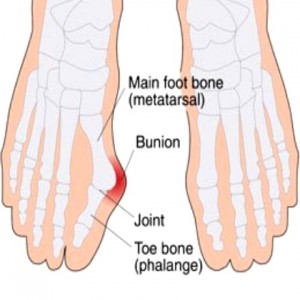Bunion Surgery, Learn the details
Heredity and shoe gear are probably the most likely reason for you to develop a bunion. Bunions occur gradually over time. Tight and/or pointy shoes that crowd the toes may result in a bunion. High heels are also suggested to cause bunions as well. There are over 100 surgeries for bunions we can list a few types of surgery.Types of bunion surgery
- Removal of part of the metatarsal head (the part of the foot that is bulging out). This procedure is called exostectomy or bunionectomy.
- Realignment of the soft tissues (ligaments) around the big toe joint
- Making small cuts in the bones (osteotomy) and moving the bones into a more normal position
- Removal of bone from the end of the first metatarsal bone, which joins with the base of the big toe (metatarsophalangeal joint). At the metatarsophalangeal joint, both the big toe and metatarsal bones are reshaped (resection arthroplasty).
- Fusion of the big toe joint
- Fusion of the joint where the metatarsal bone joins the mid-foot(Lapidus procedure)
- Implant insertion of all or part of an artificial joint

Bunion surgery generally involves an incision in the top or side of the big toe joint and the removal or realignment of soft tissue and bone. Research does not show which type of surgery is best—surgery needs to be specific to your condition.
Is Bunion Surgery For You?
If nonsurgical treatment fails, you may want to consider surgery. Many studies have found that 85 to 90 percent of patients who undergo bunion surgery are satisfied with the results.
Reasons that you may benefit from bunion surgery commonly include:
- Severe foot pain that limits your everyday activities, including walking and wearing reasonable shoes. You may find it hard to walk more than a few blocks (even in athletic shoes) without significant pain.
- Chronic big toe inflammation and swelling that doesn’t improve with rest or medications.
- Toe deformity-a drifting in of your big toe toward the small toes.
- Toe stiffness-inability to bend and straighten your toe.
- Failure to obtain pain relief from non-steroidal anti-inflammatory drugs. Their effectiveness in controlling toe pain varies greatly from person to person.
- Failure to substantially improve with other treatments such as a change in shoes and anti-inflammatory medication.
As you explore bunion surgery, be aware that so-called “simple” or “minimal” surgical procedures are often inadequate “quick fixes” that can do more harm than good. And beware of unrealistic claims that surgery can give you a “perfect” foot. The goal of surgery is to relieve as much pain, and correct as much deformity as is realistically possible. It is not meant to be cosmetic.
Interested in learning about healthy feet ?



